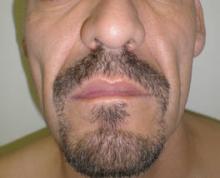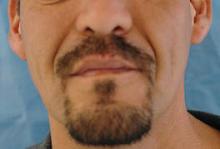SANTA BARBARA, Calif. - Fat transfer for lipoatrophy is safe and cost effective, and provides excellent long-term results, lasting over a year in some cases, said Dr. Ilya Reyter.
Dr. Reyter, along with Dr. David Sawcer, launched a lipodystrophy clinic in the department of dermatology at the University of Southern California's Keck School of Medicine in early 2007. The clinic is dedicated to treating HIV-associated lipodystrophy and lipoatrophy using tumescent liposuction and fat transfer.
Dr. Reyter, an assistant clinical professor of dermatology at the university, also has extensive experience with fat transfer and liposuction for non-HIV cosmetic improvement, and performs the procedure in his private practice in Beverly Hills, Calif.
Lipodystrophy is marked by central fat deposition on the abdomen, dorsocervical area, salivary glands, breasts, face, and neck. "Before we started this clinic, a lot of our patients were being sent to plastic surgeons, especially for excision of lipodystrophy, particularly in the dorsocervical area," Dr. Reyter said. The dystrophic fat accumulations can be removed more simply using local anesthesia with tumescent liposuction, thereby avoiding the risks of surgery with general anesthesia, he said.
Patients are referred to the HIV lipodystrophy clinic by the HIV dermatology clinic and by other physicians working with HIV patients at the medical school. Dr. Reyter has treated numerous patients for non-HIV cosmetic fat transfer, "but in the HIV clinic, we have treated a few dozen patients," he said. "We select the patients carefully, to make sure that they are appropriate candidates. Not everyone with facial atrophy is a candidate for fat transfer, or fillers, for that matter."
He went on to describe his methods for treating lipoatrophy using fat transfer. Lipoatrophy, also know as fat wasting, particularly affects the face, and is marked by prominent zygomata, reduction of Bichat’s fat pads, sunken eyeballs, and a cachectic appearance.
HIV-associated lipoatrophy was recognized shortly after the first protease inhibitors were approved in 1995. "You can see some of these features in patients who are HIV positive but not on any medication, but it's a really small subset, only about 3% of them," said Dr. Reyter.
He said that lipoatrophy has replaced Kaposi’s sarcoma as the "scarlet letter" of HIV disease, "and it can lead to noncompliance with therapy. It has been shown that correction of the problem can lead to physical and psychological improvement. Lipoatrophy is increasing in prevalence, because HIV is becoming a chronic disease. The longer patients are on medications for their disease, the more of this we will see. The patients have nowhere else to go. As dermatologists we are the experts of skin and subcutaneous fat. If we don't treat it, who will?"
The exact causes of lipoatrophy and lipodystrophy remain unclear, but they are most likely related to multiple factors, he said, including a decrease in retinoic acid receptors, a decrease in triglyceride uptake, inhibition of mitochondrial DNA, inhibition of lipid metabolism, and prevention of adenocyte development.
For small volume areas that need treatment, Dr. Reyter prefers hyaluronic acid fillers such as Restylane and Juvéderm, but for large volume areas such as the cheeks, fillers "don't last a very long time, and they cost a lot. To me, those are prohibitive features for being widely used in HIV. It was not a cost-effective model to be doing this about every 6 months, using 10-14 syringes per side on a patient's face. It just made no sense," he said.
Other filler options include poly-L-lactic acid (Sculptra) and calcium hydroxylapatite (Radiesse), but Dr. Reyter said that he has seen patients with and without HIV develop complications including granulomas after being treated with these agents. "I don't feel as comfortable offering these particular fillers," he said, even though they are Food and Drug Administration approved. "I think it's up to physicians to evaluate whether or not a filler is something they would want to use on their own patients."
Fat transfer wins out for larger volumes, he said, if donor fat is available. "Fat is very cheap to harvest; most patients have adequate fat reserves, and it can be done safely."




